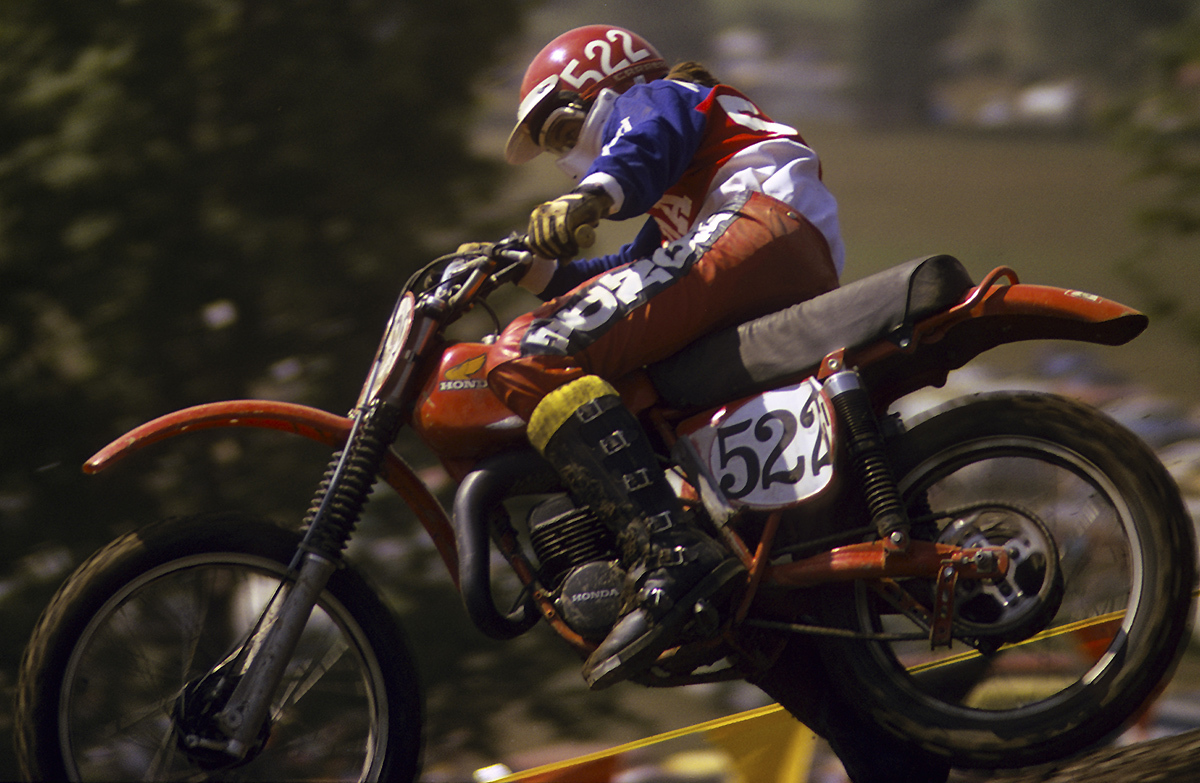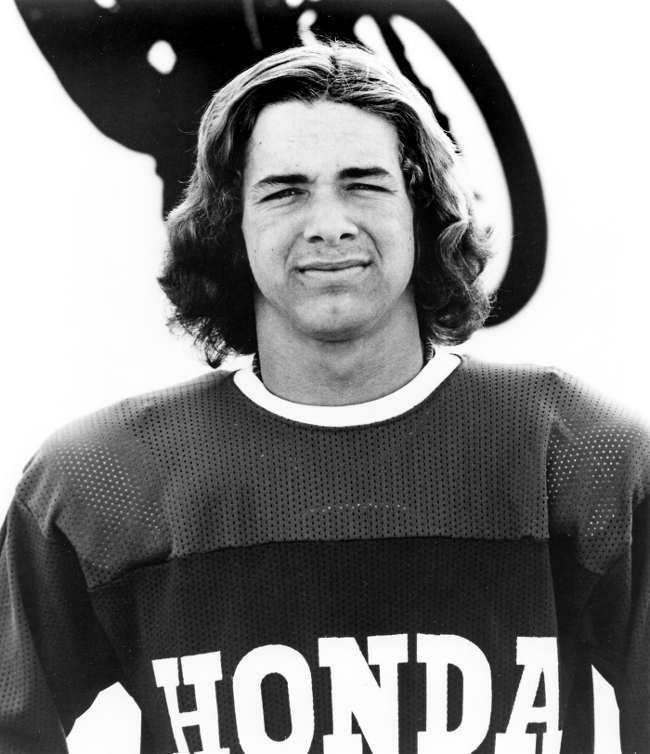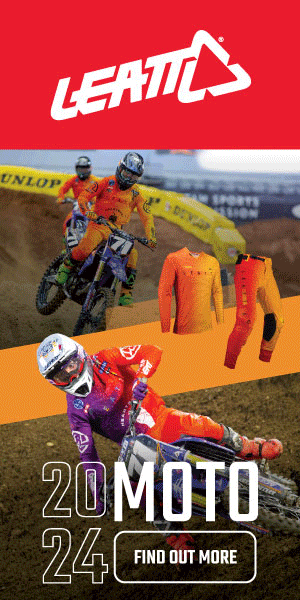Marty Smith interview
Posted on September 21, 2023
It has been nearly four years now that American motocross legend Marty Smith passed away in a dune buggy accident. The first real superstar in USA, Smith with his long blonde hair and technically beautiful riding style, Smith was everything a young kid who rode motocross wanted to be. I know I wanted to be him and I made sure I had the red, white and blue of team Honda jersey and while I couldn't afford a CR125, I bought a clapped out MT 125cc machine.
Living in Australia in the 1970s meant that the only way to really follow AMA supercross or motocross was through the pages of Motocross Action, of which I bought every month and fortunately we got the AMA results in the post, usually a month after the race was run.
When I got to visit America in 1978 with my parents, and witness the Daytona and Houston Supercross, two rounds Bob Hannah dominated and my hero, Marty Smith had a career changing injury.
When he visited Australia for the Sydney Showground supercross back around 1980, I was excited and his speed on the Suzuki factory machine might have slowed, he was still Marry Smith.
An American motocross legend and my childhood hero. I wanted to share an interview I did with him in February of 2019 a little more than a year before his death. I have run it before, but you can never get too much of the first American hero.
It isn’t often you get to interview one of your heroes, but being the owner of MXlarge has really given me some privileges, and I don’t forget that for a minute. As a 10 year old kid growing up in Australia I was thousands of miles away from Grand Prix or the AMA Nationals, but fortunately my father was a photographer in the industry and ran his own motorcycle magazines for several years. So we kept up to date, and even got to travel to America in the 1970s to witness the AMA supercross races.
Just as it is now, Australia is a country very much addicted to anything American, and for me as a kid it was the AMA Nationals that caught my eye. Back in the mid-1970s, blonde haired, blue eyed Marty Smith was the American champion, winning the 1974 and 75 125cc motocross championship and the 1977 500cc motocross championship.

His story is a very intriguing one, from a surfer kid to motocross legend. Known for his amazing talent, and his good looks, Smith dominated, winning his first AMA championship less than three years after having his first ever motocross race.
This is the first part of a two part interview with the former Honda factory rider, whose star shone bring, but flickered out in the dust of the 1978 Houston supercross, when a horrible first corner crash saw him dislocate his hip after being run over by several riders.
More on that in part two, and also his legendary battles with Bob Hannah and Roger DeCoster, his 1976 season of doing both AMA 125cc and World 125cc, and his declining to race the MXdN. Keep an eye out for part two tomorrow or Wednesday.
MXlarge: Firstly, obviously you had a great career, but can you take me back to when you first got into motorbikes?
Smith: Well, I was 13 when I first started racing. I started riding when I was six years old. My dad and his buddies used to ride out in the local trails and hills, before it got popular here in the states. Basically, they had street bikes that were cut down and they put knobbies on them, high front fenders, to make them look like a dirt bike, or as close as they thought a dirt bike should look, because they didn’t even know what a dirt bike was. These guys were the real pioneers.
MXlarge: Because from memory, wasn’t Husqvarna the first company to import dirt bikes to America?
Smith: I think so, and I think CZ wasn’t far behind them. It just a whole different era back then compared to now. As a kid it was totally different to now. Kids now start riding at three years old on a KTM SFX65cc, with ten inches of travel and putting out about 25 horsepower, these kids don’t know how good they got it.
MXlarge: I know the old videos from back in the 1970s and when Roger De Coster and Torsten Hallman came to America, they were racing the American guys on old BSA machines and stuff from memory.
Smith: Yes, you are correct.
MXlarge: Did you go to the races with your mum and dad?
Smith: Yes, my mum and dad. My father was a captain on the fire department and he had to work some Sundays. Most of the time they both went, and we used to throw my bike in the back of a pick-up truck, thrown my riding gear in there and go to the races.
MXlarge: Did you watch any International race when you were a kid, just as a fan?
Smith: You know, I can’t remember them even having Trans-AMA or anything like that. They may have had it the first year I started racing, but I was so new to the sport, I didn’t even know what a Trans-AMA was, I didn’t have a clue. I wasn’t into racing at all, just riding with my buddies after school. Then one of my mates fathers said to my dad, Marty is a pretty good racer, why don’t you enter him in one of these races at Carlsbad. They had races a couple of times a month. Sure enough, we went up there on a Sunday morning and I got up about 7am and they were already having practice. I was watching these guys going around and I thought to myself, holy crap, these guys are hauling ass and don’t even know if I want to do this. Before I could decide if I wanted to do it or not, my mum came back and had the paperwork and told me, okay honey, you are all signed up, you are in the 125 junior class and your first race is at 10.30 today. So that is how it started.

MXlarge: How did you do?
Smith: I got a fifth overall that day. Considering what happened, that was okay. There were 30 to 35 guys in my class and I was absolutely the youngest rider out there. The very first race of my life, I had turned my fuel off, so I started, had a pretty good start, was right up the front and my bike ran out of gas. I didn’t know what it was and my dad ran over and saw the gas off and I was a long way behind, but caught up to top ten, and then in the second race I think I finished second or third and finished fifth overall.
MXlarge: How was that as a young kid, racing at 14 years of age against full grown men?
Smith: I mean they were all grown men, and all rode 125’s. I would line up on the gate against a guy with a big old beer belly and a big beard. It was intimidating, but I wouldn’t look at them and let them take me down that way. I was racing and I loved riding, having a blast.
MXlarge: So you started racing, but what lead you to get a ride with Honda, because that all happened very quickly didn’t it?
Smith: The first couple of years of local riding, I kept progressing, and the first year I rode a 125cc Enduro bike. I had Preston Petty mud guards, my number plates I cut out of aluminium in a circle. I then got a Penton motorcycle, and the Penton was a real motocross bike. I had just turned intermediate on my Enduro bike, in fact, let me back up a little. When I had that Enduro bike, we put a 21 inch front tyre on it, did some work to the motor and made that thing run pretty well. I started dominating the novice class, then started winning in the intermediate class and turned expert on the Penton. When I got into the expert class, Monarch a Sweden brand offered me a sponsorship. They paid me $100 a month and gave me all the free bikes and parts I needed. I also had a local shop who was working on my bikes and taking them to the races for me. I thought I was in high heaven. I started winning on that Monarch, and then they had a big race at Glen Helen, which used to be called Royal Cycle Park. I did well at the start of the first heat, but crashed really hard. I was out for the day, but I was the fastest out there. Then we went to Hangtown, for the first round of the Nationals, in 1973. Now this was just 18 months after my first ever motorcycle race. I went to Hangtown on his Monarch and won both motos (125 support class). I got home late that night, because it was an eight hour drive home, and I wanted to stay home from school that day, and my dad said it was okay. I got a phone call from American Honda at around 9.30 that morning, asking if I wanted to ride for them in 1974, as they were putting together a 125cc campaign for the all new 125cc championship. So I went up there the following week and we signed a contract for $35,000, my very first real contract. I was 15 years old. I turned 16 in November and started racing for Honda that following year, in 1974.
MXlarge: And you won the championship straight away.
Smith: Yes, riding number 522, I got the number one plate at the end of the year.
MXlarge: Wow that is amazing. I mean I was a massive Marty Smith fan in the 1970s, but I didn’t realize how quickly you got to the top. So two years after your very first motocross race, you win the AMA 125cc National Championship that is amazing.
Smith: It was actually like two and a half years. I was very fortunate. I was in a dream World and used to wonder if it was real or not.
MXlarge: Obviously the sport was very new in America back then, and you were probably the first real superstar racing from America. The surfer with the blonde hair, good looks. I know you were a racer, but what was that like, because from memory there were beautiful woman everywhere?
Smith: You know what, it did make it hard on me. It was a crazy life. I wasn’t used to it, and I was just racing because I loved it, but I was getting all this attention from magazines and fans at the races, and the girls, they used to call pit tootsies. I didn’t know what a pit tootsie was, but they would be waiting at the hotel for us, me and Tommy Croft. They wanted to talk and look at us and get our autographs. For me it was really weird, because I didn’t know what to do and I was just focused on racing. I was just focused on being the best I could be, and working really hard to be in the best condition I could be, so I didn’t let it get to me at all. I always wanted to work harder than anyone else and I was a training fool. I mean I played racquet ball and I was riding my motorcycle almost every day of the week. That made the difference, because I knew when I was at the races, no matter who I was racing or who I lined up against, I was better prepared and that gave me a lot of confidence and I didn’t feel I could be beaten.
Images supplied by RacerX Dick Miller images











